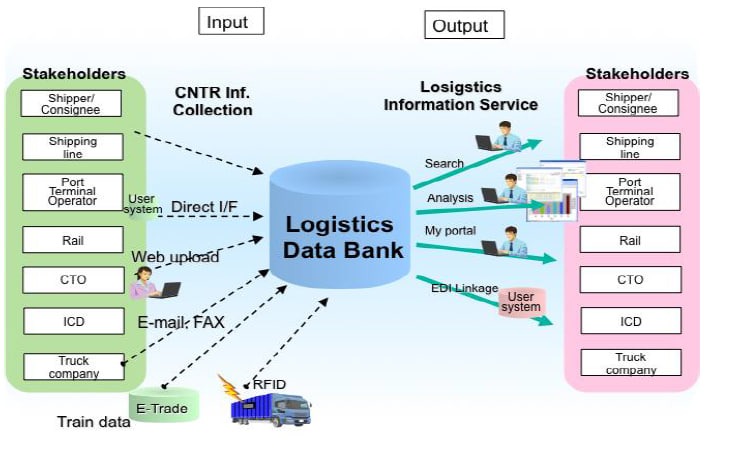
Copyright infringement not intended
Context: The Department for Promotion of Industry and Internal Trade (DPIIT) held a meeting to review the progress of the Logistics Data Bank Project (LDB), which aims to improve the efficiency and transparency of port operations in India.
Details
- The meeting was chaired by the Special Secretary (Logistics) and attended by representatives from various port authorities, customs, and other stakeholders.
- The meeting was part of the efforts to streamline and synergize the initiatives and actions of various stakeholders to improve the performance and productivity of ports in India.
- The meeting aimed to align the port-led development strategy with the ambitious EXIM target set for 2030, which is to increase India's share in global trade from 2.1% to 5%. By focusing on infrastructure development, technology adoption, and efficient logistics services, India hopes to strengthen its position in international trade and emerge as a key player in the global market.
Key points discussed during the meeting:
Targeted Interventions
- Participants emphasized the need for targeted interventions to address the issues of dwell time disparity among Indian ports and to achieve international benchmarks for key metrics such as turnaround time and congestion. They urged the port authorities to implement best practices and adopt innovative solutions to enhance port performance and productivity.
Standardization and SOPs
- The meeting discussed the importance of standardizing processes and developing Standard Operating Procedures (SOPs) for speedy cargo clearance. This would improve timeliness, and predictability, and reduce the average release time of cargo for imports and exports. The participants agreed to work on harmonizing the procedures and documentation requirements across ports and customs.
NCTF Target
- The meeting reviewed the progress made by the ports and customs in achieving the National Committee on Trade Facilitation (NCTF) target of 48 hours for sea cargo and 24 hours for air cargo clearance.
- The Special Secretary appreciated the efforts made by some ports and customs in reducing the clearance time and urged others to follow suit. He also stressed the need for regular monitoring and reporting of the clearance time data.

Initiatives by Port Authorities
- The meeting showcased some of the initiatives and projects undertaken by various port authorities to improve port performance. Some of these initiatives include setting up centralized parking plazas, real-time container tracking using LDB, construction of roads and flyovers to improve connectivity, capacity augmentation projects, and development of logistics parks.
Strategic Planning
- The meeting advised the ports to develop strategic action plans for improving port performance and productivity, to emerge as global transhipment hubs and preferred trade destinations. The Special Secretary suggested that the ports should conduct a SWOT analysis of their strengths, weaknesses, opportunities, and threats, and devise their strategies accordingly. He also offered support from the Logistics Division in facilitating the strategic planning process.
Predictive Analysis
- The meeting emphasized the need for predictive analysis for infrastructure planning to ensure adequate handling capacity for increased EXIM trade flows in the future. The Special Secretary urged the ports to use data analytics from the LDB project as a tool for forecasting demand and supply scenarios and planning their infrastructure accordingly. He also suggested that the ports should collaborate with other stakeholders such as shipping lines, freight forwarders, terminal operators, etc., to optimize their resource utilization and allocation.
Last and First Mile Connectivity
- This refers to the transportation of goods and passengers from the origin or destination to the nearest port or railway station. It is a crucial factor for enhancing the efficiency and competitiveness of hinterland connectivity, which is the movement of goods and passengers between ports and inland areas. One of the suggestions made at the meeting was to use the PM GatiShakti mechanism, which is a national master plan for multimodal connectivity that aims to integrate road, rail, air, and waterways networks.
Digital Infrastructure
- This involves the use of information and communication technologies (ICT) to improve operations and services at ports, such as cargo handling, customs clearance, security, and safety. Digital infrastructure can also enable better coordination and collaboration among various port stakeholders, such as port authorities, terminal operators, shipping lines, logistics providers, and regulators. The meeting highlighted the need to facilitate the development of digital infrastructure and increase digitization at ports.
The meeting concluded with a vote of thanks from the Special Secretary (Logistics) to all the participants for their active participation and constructive suggestions. He expressed hope that the meeting would pave the way for further collaboration and coordination among all stakeholders in improving EXIM logistics efficiency and global competitiveness
Logistics Data Bank Project (LDB)
About
- Logistics is the process of planning, implementing and controlling the efficient and effective flow of goods, services and information from the point of origin to the point of consumption. Logistics is essential for any business that wants to satisfy customer needs, reduce costs and improve operational efficiency.
- One of the challenges of logistics is to manage the large amount of data generated by various activities, such as transportation, warehousing, inventory, order processing, distribution and customer service. Data is a valuable asset that can provide insights into the performance, trends and opportunities of the logistics system. However, data is also complex, heterogeneous and distributed across different sources and formats, making it difficult to access, integrate and analyze.
- To address this challenge, we have developed the Logistics Data Bank (LDB) project, a comprehensive and innovative solution that aims to create a centralized platform for collecting, storing, processing and visualizing logistics data.
- The Logistics Data Bank Project (LDB) was launched in 2016 (Ministry of Commerce and Industry as nodal ministry) to enhance the efficiency of India's logistics sector through the use of Information Technology (IT).
- The project is being implemented through a Special Purpose Vehicle (SPV) known as Delhi Mumbai Industrial Corridor Development Corporation Logistics Data Services Ltd. (DLDSL).
- The LDB project leverages the latest technologies, such as cloud computing, big data analytics, artificial intelligence and blockchain, to provide a secure, scalable and intelligent data infrastructure for the logistics industry.

Key features of the Logistics Data Bank Project:
- RFID Tagging and Tracking: Each container is attached to a Radio Frequency Identification Tag (RFID) tag, which allows for real-time tracking of the containers using RFID readers. This helps importers and exporters to monitor the movement of their goods throughout the transit process.
- Reduced Lead Time and Transaction Costs: By implementing RFID tracking, the project has reduced the overall lead time of container movement and minimized transaction costs incurred by consignees and shippers.
- Comprehensive Coverage: The project covers the entire movement of containers, whether transported via rail or road until they reach the Inland Container Depot (ICD) and Container Freight Station (CFS).
- Single Window Information: The Logistics Data Bank integrates information from various agencies across the supply chain and provides detailed, real-time information within a single window. This streamlines the process and ensures transparency.
- Ease of Doing Business: The Logistics Data Bank Project is considered a significant "ease of doing business" initiative, as it aims to boost India's foreign trade and improve the efficiency of logistics operations.
- Nodal Ministry: The project comes under the Ministry of Commerce and Industry, indicating the government's focus on promoting trade and commerce by leveraging IT-based solutions to enhance logistics efficiency.
Objectives and benefits
- To improve the visibility and traceability of the logistics processes and assets, such as shipments, vehicles, containers and inventory.
- To enhance the decision-making and planning capabilities of the logistics stakeholders, such as shippers, carriers, freight forwarders, customs agents and regulators.
- To optimize the utilization and allocation of the logistics resources and assets, such as routes, modes, schedules and capacities.
- To reduce the operational costs and risks of the logistics activities, such as delays, damages, losses and fraud.
- To increase customer satisfaction and loyalty by providing timely, accurate and personalized information and services.
- To support the innovation and transformation of the logistics business models and processes by enabling new applications and services based on data.

Conclusion
- The LDB project is a game-changer for the logistics industry. It will create a new level of transparency, efficiency and intelligence for the logistics operations. It will also foster a data-driven culture and mindset for the logistics stakeholders.
Must Read Articles:
Unified Logistics Interface Platform (ULIP): https://www.iasgyan.in/daily-current-affairs/unified-logistics-interface-platform-ulip
Logistics Performance Index (LPI): https://www.iasgyan.in/daily-current-affairs/logistics-performance-index-lpi
National Logistics Policy: https://www.iasgyan.in/daily-current-affairs/national-logistics-policy
|
PRACTICE QUESTION
Q. What is the current potential and significance of the logistics sector in India, and how does it contribute to the country's economy? What are the major challenges hindering its growth and efficiency, and what strategies are recommended to address these challenges and unlock further growth in the Indian logistics industry?
|
https://pib.gov.in/PressReleaseIframePage.aspx?PRID=1941570





